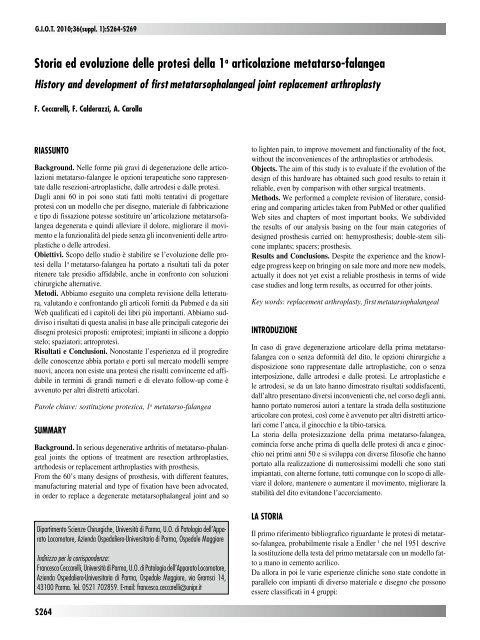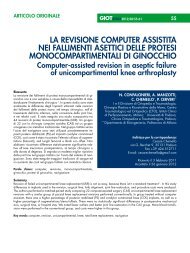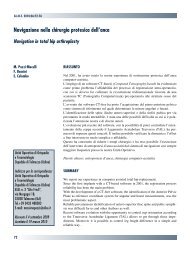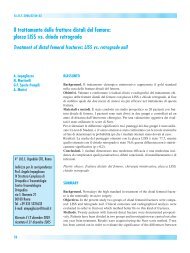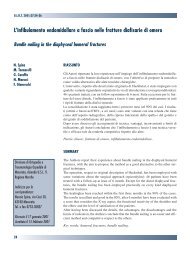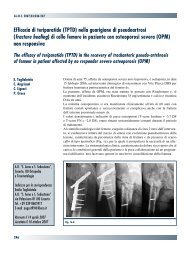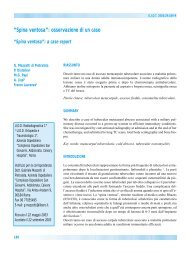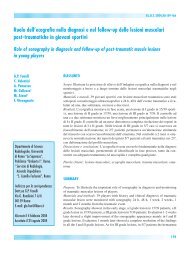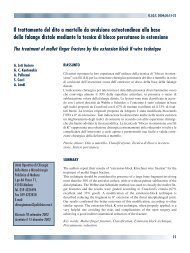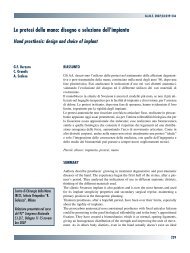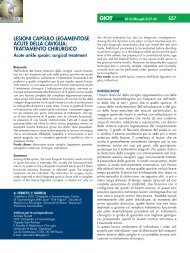30845 Suppl Giot.pdf - Giornale Italiano di Ortopedia e Traumatologia
30845 Suppl Giot.pdf - Giornale Italiano di Ortopedia e Traumatologia
30845 Suppl Giot.pdf - Giornale Italiano di Ortopedia e Traumatologia
Create successful ePaper yourself
Turn your PDF publications into a flip-book with our unique Google optimized e-Paper software.
G.I.O.T. 2010;36(suppl. 1):S264-S269<br />
Storia ed evoluzione delle protesi della 1 a articolazione metatarso-falangea<br />
History and development of first metatarsophalangeal joint replacement arthroplasty<br />
F. Ceccarelli, F. Calderazzi, a. Carolla<br />
rIaSSuNTO<br />
Background. Nelle forme più gravi <strong>di</strong> degenerazione delle articolazioni<br />
metatarso-falangee le opzioni terapeutiche sono rappresentate<br />
dalle resezioni-artroplastiche, dalle artrodesi e dalle protesi.<br />
Dagli anni 60 in poi sono stati fatti molti tentativi <strong>di</strong> progettare<br />
protesi con un modello che per <strong>di</strong>segno, materiale <strong>di</strong> fabbricazione<br />
e tipo <strong>di</strong> fissazione potesse sostituire un’articolazione metatarsofalangea<br />
degenerata e quin<strong>di</strong> alleviare il dolore, migliorare il movimento<br />
e la funzionalità del piede senza gli inconvenienti delle artroplastiche<br />
o delle artrodesi.<br />
Obiettivi. Scopo dello stu<strong>di</strong>o è stabilire se l’evoluzione delle protesi<br />
della 1 a metatarso-falangea ha portato a risultati tali da poter<br />
ritenere tale presi<strong>di</strong>o affidabile, anche in confronto con soluzioni<br />
chirurgiche alternative.<br />
Meto<strong>di</strong>. Abbiamo eseguito una completa revisione della letteratura,<br />
valutando e confrontando gli articoli forniti da Pubmed e da siti<br />
Web qualificati ed i capitoli dei libri più importanti. Abbiamo sud<strong>di</strong>viso<br />
i risultati <strong>di</strong> questa analisi in base alle principali categorie dei<br />
<strong>di</strong>segni protesici proposti: emiprotesi; impianti in silicone a doppio<br />
stelo; spaziatori; artroprotesi.<br />
Risultati e Conclusioni. Nonostante l’esperienza ed il progre<strong>di</strong>re<br />
delle conoscenze abbia portato e porti sul mercato modelli sempre<br />
nuovi, ancora non esiste una protesi che risulti convincente ed affidabile<br />
in termini <strong>di</strong> gran<strong>di</strong> numeri e <strong>di</strong> elevato follow-up come è<br />
avvenuto per altri <strong>di</strong>stretti articolari.<br />
Parole chiave: sostituzione protesica, 1 a metatarso-falangea<br />
SuMMary<br />
Background. In serious degenerative arthritis of metatarso-phalangeal<br />
joints the options of treatment are resection arthroplasties,<br />
artrhodesis or replacement arthroplasties with prosthesis.<br />
From the 60’s many designs of prosthesis, with <strong>di</strong>fferent features,<br />
manufacturing material and type of fixation have been advocated,<br />
in order to replace a degenerate metatarsophalangeal joint and so<br />
Dipartimento Scienze Chirurgiche, Università <strong>di</strong> Parma, U.O. <strong>di</strong> Patologia dell’Apparato<br />
Locomotore, Azienda Ospedaliero-Universitaria <strong>di</strong> Parma, Ospedale Maggiore<br />
In<strong>di</strong>rizzo per la corrispondenza:<br />
Francesco Ceccarelli, Università <strong>di</strong> Parma, U.O. <strong>di</strong> Patologia dell’Apparato Locomotore,<br />
Azienda Ospedaliero-Universitaria <strong>di</strong> Parma, Ospedale Maggiore, via Gramsci 14,<br />
43100 Parma. Tel. 0521 702859. E-mail: francesco.ceccarelli@unipr.it<br />
S264<br />
to lighten pain, to improve movement and functionality of the foot,<br />
without the inconveniences of the arthroplasties or artrhodesis.<br />
Objects. The aim of this study is to evaluate if the evolution of the<br />
design of this hardware has obtained such good results to retain it<br />
reliable, even by comparison with other surgical treatments.<br />
Methods. We performed a complete revision of literature, considering<br />
and comparing articles taken from PubMed or other qualified<br />
Web sites and chapters of most important books. We sub<strong>di</strong>vided<br />
the results of our analysis basing on the four main categories of<br />
designed prosthesis carried on: hemyprosthesis; double-stem silicone<br />
implants; spacers; prosthesis.<br />
Results and Conclusions. Despite the experience and the knowledge<br />
progress keep on bringing on sale more and more new models,<br />
actually it does not yet exist a reliable prosthesis in terms of wide<br />
case stu<strong>di</strong>es and long term results, as occurred for other joints.<br />
Key words: replacement arthroplasty, first metatarsophalangeal<br />
INTrODuzIONE<br />
In caso <strong>di</strong> grave degenerazione articolare della prima metatarsofalangea<br />
con o senza deformità del <strong>di</strong>to, le opzioni chirurgiche a<br />
<strong>di</strong>sposizione sono rappresentate dalle artroplastiche, con o senza<br />
interposizione, dalle artrodesi e dalle protesi. Le artroplastiche e<br />
le artrodesi, se da un lato hanno <strong>di</strong>mostrato risultati sod<strong>di</strong>sfacenti,<br />
dall’altro presentano <strong>di</strong>versi inconvenienti che, nel corso degli anni,<br />
hanno portato numerosi autori a tentare la strada della sostituzione<br />
articolare con protesi, così come è avvenuto per altri <strong>di</strong>stretti articolari<br />
come l’anca, il ginocchio e la tibio-tarsica.<br />
La storia della protesizzazione della prima metatarso-falangea,<br />
comincia forse anche prima <strong>di</strong> quella delle protesi <strong>di</strong> anca e ginocchio<br />
nei primi anni 50 e si sviluppa con <strong>di</strong>verse filosofie che hanno<br />
portato alla realizzazione <strong>di</strong> numerosissimi modelli che sono stati<br />
impiantati, con alterne fortune, tutti comunque con lo scopo <strong>di</strong> alleviare<br />
il dolore, mantenere o aumentare il movimento, migliorare la<br />
stabilità del <strong>di</strong>to evitandone l’accorciamento.<br />
La STOrIa<br />
Il primo riferimento bibliografico riguardante le protesi <strong>di</strong> metatarso-falangea,<br />
probabilmente risale a Endler 1 che nel 1951 descrive<br />
la sostituzione della testa del primo metatarsale con un modello fatto<br />
a mano in cemento acrilico.<br />
Da allora in poi le varie esperienze cliniche sono state condotte in<br />
parallelo con impianti <strong>di</strong> <strong>di</strong>verso materiale e <strong>di</strong>segno che possono<br />
essere classificati in 4 gruppi:


